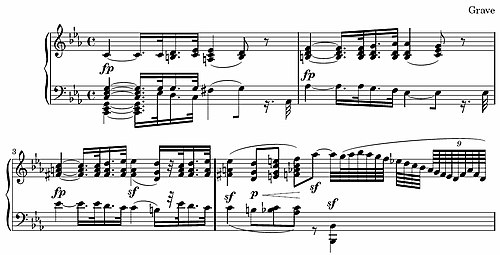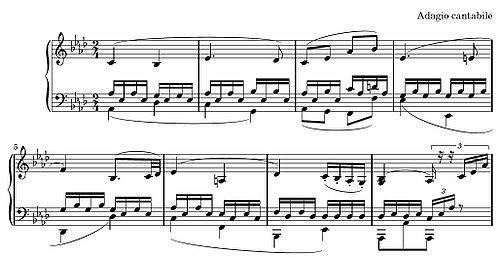Piano Sonata No. 8 (Beethoven): Difference between revisions
No edit summary |
Cliff smith (talk | contribs) m rm link in title |
||
| Line 1: | Line 1: | ||
[[Ludwig van Beethoven]]'s '''Piano Sonata No. 8 in |
[[Ludwig van Beethoven]]'s '''Piano Sonata No. 8 in C minor, op. 13,''' commonly known as '''Pathétique,''' was published in [[1799]], though written the year before, when the composer was 28 years old. Beethoven dedicated the work to his friend [[Prince Karl von Lichnowsky]].<ref name= "AllAboutBeethoven">[http://www.all-about-beethoven.com/patetica.html Beethoven Pathetique Sonata Op. 13] All About Beethoven. Retrieved [[May 1]], [[2008]].</ref> Although commonly thought to be one of the few works to be named by the composer himself, it was actually named (to Beethoven's liking) by the publisher, who was impressed by the sonata's tragic sonorities.<ref>Burkhart, Charles: "Anthology for Musical Analysis", page 233. Schirmer 2004.</ref> |
||
The Pathétique Sonata is perhaps the earliest of Beethoven's compositions to achieve widespread and enduring popularity.<ref name= "AllAboutBeethoven" /> It is widely represented on the concert programs and recordings of professional [[piano| pianists]].<ref name= "AllAboutBeethoven" /> As one of the more famous Beethoven pieces, it has been incorporated into several works of [[popular culture]] (e.g. it is used as the theme of the film ''[[The Man Who Wasn't There]]'' and Billy Joel's "This Night" from his album ''[[An Innocent Man]]''). Beethoven's Pathetique remains one of his most popular sonatas. |
The Pathétique Sonata is perhaps the earliest of Beethoven's compositions to achieve widespread and enduring popularity.<ref name= "AllAboutBeethoven" /> It is widely represented on the concert programs and recordings of professional [[piano| pianists]].<ref name= "AllAboutBeethoven" /> As one of the more famous Beethoven pieces, it has been incorporated into several works of [[popular culture]] (e.g. it is used as the theme of the film ''[[The Man Who Wasn't There]]'' and Billy Joel's "This Night" from his album ''[[An Innocent Man]]''). Beethoven's Pathetique remains one of his most popular sonatas. |
||
Revision as of 05:39, 10 October 2008
Ludwig van Beethoven's Piano Sonata No. 8 in C minor, op. 13, commonly known as Pathétique, was published in 1799, though written the year before, when the composer was 28 years old. Beethoven dedicated the work to his friend Prince Karl von Lichnowsky.[1] Although commonly thought to be one of the few works to be named by the composer himself, it was actually named (to Beethoven's liking) by the publisher, who was impressed by the sonata's tragic sonorities.[2]
The Pathétique Sonata is perhaps the earliest of Beethoven's compositions to achieve widespread and enduring popularity.[1] It is widely represented on the concert programs and recordings of professional pianists.[1] As one of the more famous Beethoven pieces, it has been incorporated into several works of popular culture (e.g. it is used as the theme of the film The Man Who Wasn't There and Billy Joel's "This Night" from his album An Innocent Man). Beethoven's Pathetique remains one of his most popular sonatas.
Prominent musicologists debate whether or not the Pathétique may have been inspired by Mozart’s piano sonata K. 457, since both compositions are in C minor and have three very similar movements. The spacious second movement of Mozart's sonata, especially, makes use of a theme remarkably similar to that of the second movement, "Adagio cantabile," of Beethoven's.[3] However, Beethoven's sonata uses a unique motif line throughout, a major difference from Haydn or Mozart’s creation.[1]
In its entirety, encompassing all three movements, the work takes approximately 19 minutes to perform.
Movements
The sonata has three movements:
- Grave (Slowly, with solemnity) - Allegro di molto e con brio (Quickly, with much vigour)
- Adagio cantabile (Slowly, in a singing style)
- Rondo: Allegro (Quickly)
Grave - Allegro di molto e con brio
The first movement is in sonata form. It begins with a slow introductory theme, marked Grave. The allegro section is in 2/2 time in the home key of C minor, modulating, like most minor-key sonatas of this period, to the mediant, E flat - however Beethoven makes use of unorthodox mode-mixture, as he presents the second subject in e-flat minor rather than its customary parallel major. Beethoven extends Haydn's compositional practice by returning to the introductory material, not once but twice - at the beginning of the development section as well as in the coda.
Beethoven did not specify precisely where the first movement's repeat should begin. Pianists traditionally start the repeat at the beginning of the Allegro, but some choose to start from the very beginning of the piece (Grave). This latter option reflects Beethoven's beginning the development section with the slow theme.

Musicologist Donald Francis Tovey suggested leaving out the repeat altogether.[4]
Adagio cantabile
The Adagio movement opens with a famous cantabile ("in a singing style") melody. This theme is played three times, separated by two modulating episodes: the first episode moves from F minor to E-flat major, and the second from A-flat minor to E major. With the final return of the main theme, the accompaniment becomes richer and takes on the triplet rhythm of the second episode. There is a brief coda.

Rondo: Allegro
The sonata closes with a 2/2 movement in C minor. The main theme closely resembles the second theme of the Allegro of the first movement: its melodic pattern is identical for its first four notes, and its rhythmic pattern for the first eight. The movement's sonata rondo form includes a coda. The three rondo episodes are in E flat, A flat, and C major. The common use of sforzandos create a forceful effect, although overall the rondo is relatively lightweight compared to the first movement.
Media
Template:Multi-listen start Template:Multi-listen item Template:Multi-listen end
See also
References
- ^ a b c d Beethoven Pathetique Sonata Op. 13 All About Beethoven. Retrieved May 1, 2008.
- ^ Burkhart, Charles: "Anthology for Musical Analysis", page 233. Schirmer 2004.
- ^ Marks, F. Helena. The Sonata : Its Form and Meaning as Exemplified in the Piano Sonatas by Mozart. Norbury Crescent: New Temple P, 1921.
- ^ Tovey, Donald Francis. Beethoven - Sonata in C minor for piano - Op.13 'Pathetique'. ABRSM Publishing. ISBN 1-85472-015-5.
{{cite book}}: Cite has empty unknown parameter:|1=(help); Unknown parameter|coauthors=ignored (|author=suggested) (help)
External links
- Ricordi edition of the score. William and Gayle Cook Music Library at the Indiana University School of Music.
- A public domain engraving of the score using GNU LilyPond and MIDI files are available from the Mutopia Project in several formats.
- Brief analysis of the Pathétique Sonata and free score on the All About Ludwig van Beethoven Pages.
- A YouTube video of this sonata played by Freddy Kempf.
- For a public domain recording of this sonata visit Musopen
- Free scores by Piano Sonata No. 8 at the International Music Score Library Project (IMSLP)
